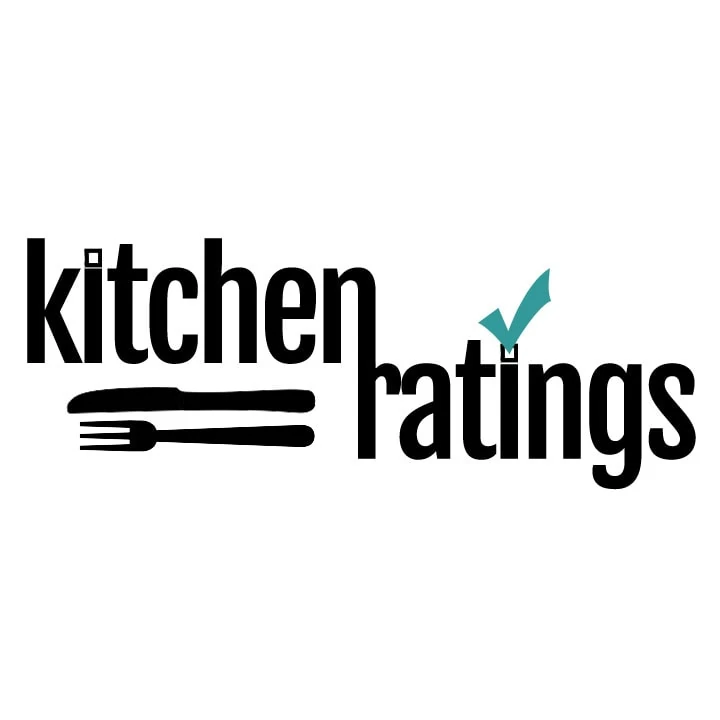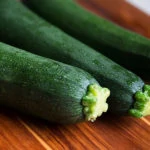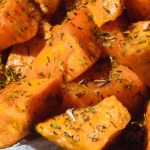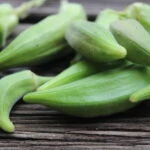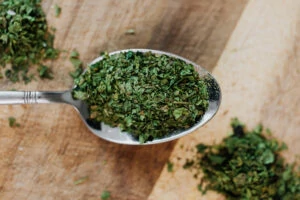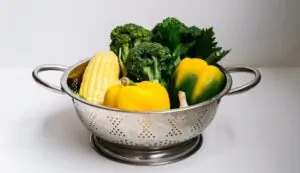A cutting board is an essential tool, both in professional culinary kitchens and the kitchen of a home cook. You need them for just about any food prep that involves slicing, dicing, cutting, or any other kind of prep.
A carving board or cutting board is great for protecting your knives and counters from each other when chopping, keeping food and mess contained in a juice groove, and keeping your kitchen a much safer, germ-free space. If you don’t already own a reliable cutting board, there’s no time like the present to find the perfect one!
One of the biggest factors to take into consideration when buying a kitchen cutting board is its size. You might think size only matters when it comes to kitchen storage space, but it affects much more. Depending on the size of your cutting board, it will be better suited for prepping different foods and accomplishing different cooking techniques.
We want you to be totally in the know, which is why we’ve written this cutting board size guide. Let’s explore the common size ranges you’ll find when shopping for cutting boards, and what they are best suited for.
Cutting Board Sizes
Let’s learn all about cutting board sizes! For the majority of these examples, we’ll be exploring the sizing of traditional rectangular cutting boards. However, there are round cutting boards, and fun novelty shapes boards out there!.
Small Cutting Boards
Small cutting boards will often be anywhere between 4 x 6 inches in size, up to 10 x 8 inches, and are meant for lighter, more delicate work. Depending on what you’re preparing, though, a small cutting board might be best for the task.
The benefit of a small cutting board is that they are super easy to store in any kitchen. If you’re tight on kitchen storage space, a smaller board might be your best friend.
Small cutting boards aren’t suited for cooking for more than 1-2 people, and even then, they can’t handle super huge foods. You won’t be able to safely prep a whole bird or fish on a board of this size.
However, it’s great for any work with herbs, small fruits, and vegetables, or preparing things like cheese for a snack. Small cutting boards are also a favorite of bartenders, who need something compact to prepare ingredients like citrus behind a bar.
If you have smaller ingredients to prep and want a dedicated board, small-sized cutting boards are perfect.
Medium Cutting Boards
A medium-sized cutting board will be around 10 x 14 inches in size but can go up to 15 x 20. These are the most common size ranges you’ll find for cutting boards, as they’re perfect for the average home cook. These can be stored in most kitchen cupboards or counters easily.
These boards are great for most common kitchen prepping. If you need to chop up veggies, cut a loaf of bread, or work with one or two steaks, this board is a perfect fit.
Most home cooks will own one or two medium-sized cutting boards to do multiple tasks at once and avoid cross-contamination. It’s super common to find sets of cutting boards that cover the medium to small size ranges if you want to have different options.
Large Cutting Boards
A large cutting board will be somewhere between 7 x 23 inches or 18 x 24 inches. Typically larger boards tend to become more long and narrow, though it is possible to find larger square shapes, especially when looking for commercial grade equipment.
With a large-sized board, you should have no problem prepping anything and everything! It fits most cuts of meat and can prepare any fruits or vegetables you encounter.
A large board is great when cooking for a large family or people working in professional kitchens. You can fit a lot more on these boards, making it great for prepping mass quantities of an ingredient.
Large boards are also versatile in their use, especially if you need a serving platter. A beautiful wood cutting board made of bamboo, maple, or walnut, in this size range is great as an appetizer tray, a veggie platter, or a charcuterie board.
As sizes this big are hard to store in most kitchen cupboards, they work best when displayed on countertops. As they will always be in view, it can be nice to go with something that matches your kitchen, like a nice wood cutting board.
Extra Large Cutting Board
An extra-large cutting board will be between 18 x 30 inches or 20 x 30 inches. These boards are about as big as they get when shopping in-store unless you want something massive and custom-made.
Extra-large boards are found, most often, in professional commercial kitchens. These boards are for everyday, heavy-duty kitchen prep work. If you’re cutting up enough cabbage to feed hundreds or parsley garnish to last an entire day, this is the board to do it.
Some home cooks prefer extra-large sizes, though, as these boards can hold pretty much everything. If you’re making a salad dressing, you can set all your ingredients, and even utensils, on a board this size and do it all.
These boards are also amazing for carving larger pieces of meat. Turkeys are no problem for a board this big. You can even work with larger fish, like salmon or tuna, no problem.
This board is great for the home cook looking to protect their counters or those who prefer their cutting board to act more like a workspace. They also work amazingly for appetizers or charcuterie purposes, feeding an even bigger crowd than a large board.
Does Cutting Board Thickness Matter?
Cutting boards, as you can see, come in all sorts of sizes! But what about their thickness? Does this affect their effectiveness at all?
In short, yes, thickness matters, depending on what you’re doing with the board. With certain materials, their thickness will have a huge impact on the board’s ability to work.
Some materials, like plastic, silicone, or rubber cutting boards, will be pretty effective no matter how thick or thin they are. For materials like wood or glass, though, a thin board will not work as well as a thick one, like butcher block cutting boards.
If a wooden cutting board is too thin, it will be more prone to water damage, warping, or cracking over time. With glass, a thin material will make the board easily breakable, which is not so safe when working with knives. While plastic and silicone are hard no matter what their thickness, plastic that is too thin is more susceptible to heat damage and warping, especially in the dishwasher.
We recommend that no matter the size, your cutting board is at least 1-2 inches thick. This will make your cutting board and cutting surface less likely to become damaged.
Does Cutting Board Shape Matter?
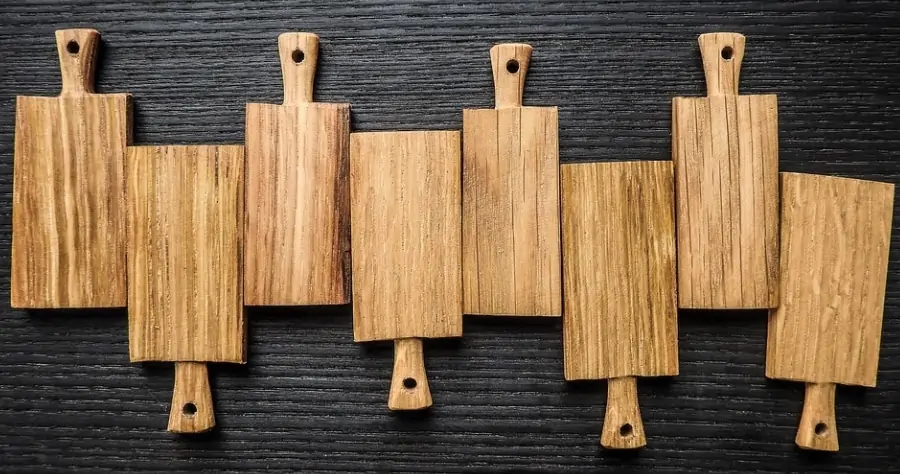
The shape of your cutting board will have some effect on what you can do with it.
As we touched on above, the most common shape for a cutting board you’ll find is a rectangle. Rectangular shapes are a great choice, as they will provide the most surface area possible to work with. They’re also easy to store, clean, and work with over time.
You’ll also encounter round cutting boards, but these can be trickier to work with. Circular cutting boards have a much smaller working surface area, making it hard to get the most out of your board. They can also be more troublesome to store for some cooks.
There are novelty-shaped cutting boards out there that come in all kinds of designs! If you’ve ever wanted a cutting board shaped like a heart or even a pig, it’s out there! These boards are even worse than round boards when it comes to the cutting surface area, though.
The shape of these boards can make them difficult to work with, especially when prepping anything large that needs a flat surface. They’re also more prone to damage and knife marks due to their irregular shapes. However, they are super cute and can look great in a kitchen. While we don’t recommend making a novelty board your go-to choice for cooking dinner, they are great for use as a cheese board or serving tray!
How To See If You Have The Right Sized Cutting Board
We have a super simple test to use if you want to see if your current cutting board is too big or too small.
For your cutting board to be used safely, it should be large enough to take the entire blade length of your favorite prep knife. If your board is too small for your knife, accidents can happen.
The test to see if your board is too small for your knife blade is simple! All you need to do is take your favorite prep knife and lay it diagonally across your board. If there is at least an inch of space on the top and bottom ends of your knife, your board is a great size!
Of course, you can use big knives on small boards. This test is just to ensure you’re using your cutting board as safely as possible.
